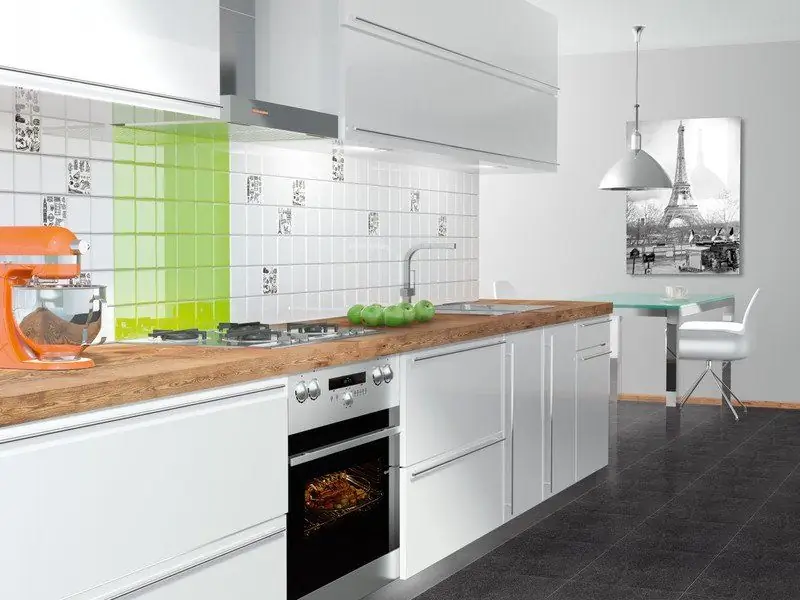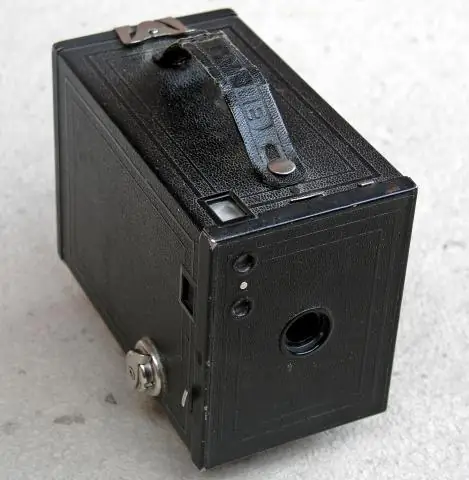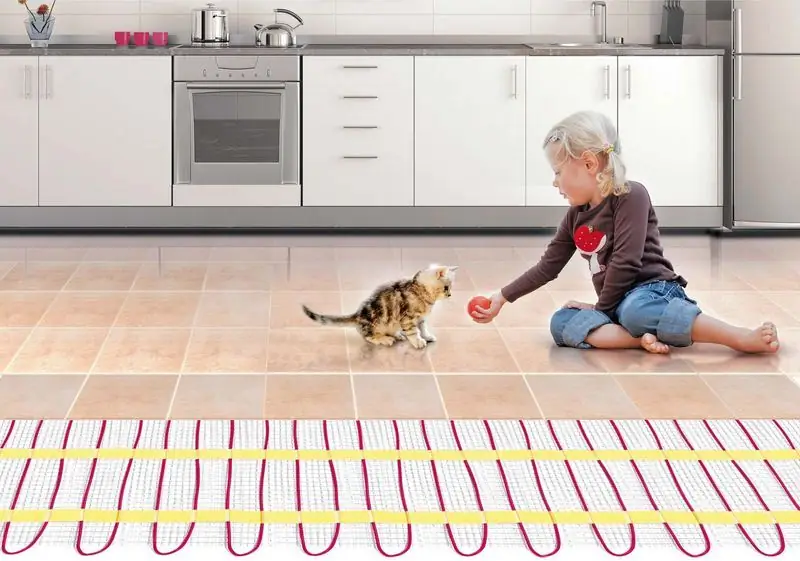
Table of contents:
- Author Bailey Albertson [email protected].
- Public 2024-01-17 22:26.
- Last modified 2025-01-23 12:41.
Tiled kitchen design

Steam and food drops are not a problem if the wall above the kitchen work surface is protected by an apron. Most often it is made from ceramic tiles measuring 10 * 10 cm. This format is chosen because of the ease of installation while maintaining all good performance properties.
Content
-
1 Feature of square tiles for the kitchen
1.1 Video: requirements for kitchen tiles
-
2 Recommendations for the selection of tile material
-
2.1 Color, pattern and texture of tiles
2.1.1 Photo gallery: what a 10x10 cm tile looks like in the kitchen
- 2.2 Other tips
-
-
3 Ideas for decorating kitchen design with tiles
-
3.1 Tile apron
1 Photo gallery: decorating the kitchen unit apron with tiles
-
3.2 Tiled walls
3.2.1 Photo gallery: kitchen walls with tiles
-
-
4 Tips for laying 10x10 cm tiles
4.1 Video: detailed tile laying technology in the area of the kitchen backsplash
Feature of square tiles for kitchen
A 10x10 cm tile is considered miniature, which makes it a suitable material both for decorating individual sections of the kitchen and for cladding the walls of the entire room.
The advantages of this material are obvious:
- good performance characteristics, including strength, shock resistance, durability, and fire and water resistance;
- Convenience of laying out even in narrow areas without the need for cutting with a diamond disc or tile cutter;
- the ability to create patterns and drawings (moreover, the composition can be stretched over the entire wall, concentrated in only one part of it, or scattered over the entire surface);
- compatibility with inserts and panels from a different material, as well as tiles of a different size;
- the ability to visually expand the space of a small kitchen;
- admissibility of use in premises, regardless of their style orientation;
- acceptable price.
The disadvantages of square tiles include:
- fragility, that is, the material is prone to the appearance of chips during inaccurate movement and storage;
- the need to level the surface before installation;
- long styling process;
- complex dismantling.
Video: requirements for kitchen tiles
Recommendations for choosing a tile material
Not every tile presented in a hardware store is suitable for kitchen cladding.
Color, pattern and texture of tiles
The color of the tiles for finishing the kitchen can be any color, as long as it is combined with the surrounding space. However, it is better to choose:
- white that matches any interior;
- beige brown, making dirt less visible.
It is recommended to use tiles of bright color if furniture of a discreet shade and light textiles are placed in the kitchen. Neutral colors harmonize better with elements of rich tones.

Square tiles in bright colors will brighten up a bright kitchen
The most popular designs for kitchen tiles are vegetation, including flowers, animals, dishes and pictures of nature.
In terms of texture, the surface of a kitchen tile can be:
- shiny, making the drawings three-dimensional, and the space around - wider. True, the gloss forces you to constantly wash the surface, removing noticeable drops of water and grease;
- matte, which makes the image clear and soft;
- embossed, although due to the presence of gaps clogged with dirt, such a surface is difficult to clean;
- smooth, the main advantage of which is practicality. Tiles without irregularities are less clogged with grease.
Photo gallery: what a 10x10 cm tile looks like in the kitchen
-

Floral tile -
A kitchen apron can look like a floral belt enclosed between lines of solid tiles.
-

Brightly Colored Cell Apron - Squares of juicy black, red and green colors will decorate the apron of a brown kitchen, if combined with white elements
-

Kitchen with a gray apron - The tile on the kitchen apron can be plain gray or painted with various patterns
-

Composition of tiles with patterns on a kitchen apron - A kitchen apron looks great if it has a pattern that looks like flower petals and stems
-

Yellow square tiles in the kitchen -
Glossy yellow tiles combined with white tiles create a warm and sunny atmosphere in the kitchen
-

Light square tiles with a pattern in the kitchen - If you want to give the kitchen a little charm, you can use tiles with an urban theme
-

Embossed white tiles on the kitchen apron - Embossed white tiles with an interesting 3D pattern make the kitchen look extraordinary
-

Red and yellow square ceramic tiles combined with floral details - A kitchen with a bright yellow set deserves an apron decorated with red and lemon checkerboard tiles
-

Vegetable square ceramic tiles in the kitchen - A tile apron looks original if it is made not only of linear tiles, but also rhombuses and squares of a contrasting color
-

Glossy square ceramic tiles with floral pattern in the kitchen - Use glossy white and colored tiles in the kitchen to create pictures of flowers and ferns
Other Tips
When looking for tiles that are suitable for your kitchen, you should look at:
- the presence of a protective coating marked A or AA, which protects the material from destruction by chemicals used to clean kitchen surfaces;
- evenness of the color of the material. It is acceptable if the tiles differ slightly in tone, because different parties are not fired to the same degree;
- glaze quality. There should be no cracks, abrasions or chips on the product.
Kitchen design tiling ideas
A convenient and successful option is tiling the apron or kitchen walls.
Tile apron
To decorate a kitchen apron with tiles in a 10x10 cm format, the following options are used:
- monochromatic elements, the color of which matches the color of the walls, floor or furniture;
- plain tiles with a color that creates a contrast with other surfaces and objects of the room;
-
monochromatic cells of a color that stands out strongly against the background of the kitchen space, for example, rich red, black or bright orange. Such material is especially suitable for light, including completely white, kitchens and obliges to decorate the room with a tablecloth, curtains or dishes of an identical catchy shade;

Contrast apron An apron can represent an accent in the decor
- tiles of two tones of the same color (for example, bright and muted), placed by analogy with a chessboard. Acceptable combinations are red plus pale pink and dark brown plus dull sand;
-
cells of two opposite (most often standard) colors, for example, white and black, red and white, black and red, yellow and green;

Apron made of black and white tiles Opposite colors look no less harmonious than plain walls
-
a composition of squares, rhombuses or other geometric shapes;

Diamond apron in the kitchen Laying tiles does not have to be strictly horizontal
- a border of tiles of the same color against the background of cells of a different color;
- figures or a border made of square tiles, surrounded by the same material, but of a different shape (for example, "hog" tiles);
-
tile with a pattern, laid out in the form of large squares or rhombuses, located in the middle of a regular plain tile;

Patterned tile in the kitchen The pattern can be combined with several tiles
- vertical lines of the same color crossing a background colored differently;
-
a panel composed of tiles with a pattern on a natural theme;

Panels in the kitchen Tiles can be used to create large, solid images
- a chessboard, where monochromatic elements alternate with those with a pattern;
- a composition of tiles, each of which has a different pattern;
- combining tiles with an uneven image with monochromatic elements of a neutral shade, attracting attention to the drawings.
Photo gallery: decorating the kitchen unit apron with tiles
-

Apron made of white tiles measuring 10x10 cm - A kitchen apron shines clean when made with only white square tiles
-

Kitchen apron in apples - White tiles can be used to assemble a mosaic - a composition of apples
-

White square tiles in the kitchen with a red set - An apron made of white tiles goes well with a bright red headset
-

Trim with square tiles with kitchen apron patterns - The backsplash finish looks particularly sophisticated when the tiles are lined with horizontal lines with different fancy patterns.
-

Apron decorated with tiles in several colors - In a completely white kitchen, the apron, where solid white tiles and patterned elements are placed between the red and green lines, enlivens the atmosphere
-

Composition of rhombuses - Using tiles for finishing the apron, you can create an interesting composition of rhombuses
-

Kitchen backsplash square tiles - Laying tiles either in squares or in rhombuses, even from a simple material it will turn out to create an unusual apron
-

Kitchen apron with bright accessories - In a bright kitchen, in which there are colorful elements such as colored pillows and towels, tiles with a large number of patterns and images should be used to decorate the apron.
-

Rectangle on the apron of the kitchen unit - In the center of the white tile apron can be any shape, for example, a rectangle of beige tiles with a pattern
-

Light apron with squares - It is recommended to dilute light glossy tiles on the kitchen apron with squares of colored elements
-

Apron made of light tiles with stains - An apron made of light-colored tiles with stains often includes brighter cells with a pattern.
-

Coffee Themed Kitchen Apron - Pictures of coffee beans are added to the cluster of gray squares of the kitchen apron
Tiled walls
When decorating kitchen walls with 10x10 cm tiles, the following ideas are most often brought to life:
- plain tiles (white or beige) on each wall of the room;
- monochromatic tiles on all walls, except for one, which is decorated with different tiles in a checkerboard or other order;
- monochromatic tiles on only three walls, and on the fourth - the use of ceramic elements that create an image with a plant theme;
-
a belt of ceramic tiles, passing in the middle through all walls covered with wallpaper or trimmed with other material;

Wallpaper and tiles in the kitchen Tiles can even be combined with wallpaper
- wall decoration with tiles only half. At the same time, an area near the ceiling usually remains decorated with a different building material.
Photo gallery: kitchen walls with tiles
-

Beige tiles on the walls of the kitchen - The walls of the kitchen are decorated with beige tiles with streaks, and the apron is decorated with tiles of the same color with patterns in the form of circles and snowflakes.
-

Beige and green tiles in the kitchen - To prevent the walls of the kitchen from merging with the floor, more green squares of tiles are concentrated at the bottom of the kitchen, and beige in the middle and above.
-

Brown tiles on the walls and floor of the kitchen - In the kitchen, it is advisable to tile the floor and the lower half of the walls with tiles.
-

Kitchen tiled in two colors - The kitchen can be tiled according to the principle "white top - dark bottom"
-

Kitchen with light and dark wall tiles - The white top of a tiled kitchen is often separated from the dark bottom by a belt of narrow, patterned tiles.
-

A kitchen where one wall is decorated with patterned tiles - Kitchen walls with beige and gray tiles look more impressive if diluted with a section with tiles decorated with interesting patterns
-

Kitchen with one wall with square tiles - In the kitchen, it is advisable to finish at least the wall with tiles, next to which the kitchen cabinets are located
-

Kitchen with walls and floors tiled with beige and white tiles - The upper part of the walls in the kitchen is often whitewashed, and the lower, like the apron, is covered with tiles.
-

Tiled kitchen - When the area next to the hood and hob is tiled with light-colored patterned tiles and the rest of the walls are decorated with pink material, the kitchen looks chic.
-

Kitchen with tiles in brown and green tones - In addition to the backsplash, square tiles can be laid on the countertop and the lower part of the kitchen walls
Tips for laying 10x10 cm tiles
In order for a square tile to serve properly, it is laid according to certain rules:
- The surface is carefully leveled, smearing a special composition with a trowel in a circular motion until it turns into a flat surface.
- They treat about a square meter with tile glue in the center of the working area (you cannot use a lot of glue), and then spread the composition over the entire surface with a spatula.
-
The tiles are carefully pressed against the wall, leveled and released slowly.

The process of gluing tiles to the wall Each tile must be pressed against the glue-treated surface for 30 seconds
- The seams between the cells are carefully cleaned of excess glue.
-
After a few days, the joints of the tiles are moistened with a sponge and, in order to avoid the appearance of fungus, they are subjected to jointing, that is, they are treated with a moisture-resistant and dirt-repellent agent (preferably epoxy grout).

Tile grouting process To prevent dirt from getting into the joints between the tiles, the wall surface after laying the material is covered with epoxy grout
Video: detailed technology for laying tiles in the area of a kitchen apron
The 10x10 cm tile has a reputation for being a practical finishing material for the kitchen. It becomes an interesting decoration of the walls or apron of a kitchen unit and serves for a long time without complaints, unlike soiled wallpaper.
Recommended:
Raspberry Eurasia - Description Of The Variety, Photos And Characteristics, Advantages And Disadvantages, Planting And Care Features With Photos And Reviews

Description of remontant raspberry Eurasia, features of planting, care, advantages and disadvantages of the variety. Photo and video
Warm Floor In The Kitchen Under The Tiles: Features, Advantages And Disadvantages, Installation, Photo

What is underfloor heating and its types. Recommendations for choosing a coating for underfloor heating. The sequence of work on the installation of a warm floor
Venetian Plaster In The Kitchen: Features, Advantages And Disadvantages, Application To Walls, Design Options, Photo

What is Venetian plaster, its advantages and disadvantages. How to choose the right material and tools for its application. Finishing steps and wall design
Laminate Kitchen Apron: Characteristics, Advantages And Disadvantages, Examples With Photos

Laminate kitchen apron: advantages and disadvantages. How to choose material. Installation and decoration tips. Design options
Roofing Made Of Ceramic Tiles, Its Structure And Main Elements, Installation And Operation Features

Types and main manufacturers of ceramic tiles. Tiled roof device. How to correctly calculate the parameters and install ceramic tiles
